
All categories
Featured selections
Trade Assurance
Buyer Central
Help Center
Get the app
Become a supplier

(918 products available)
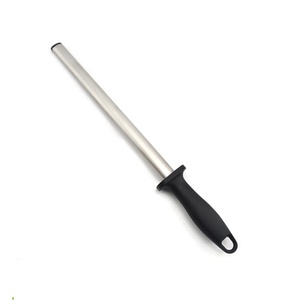
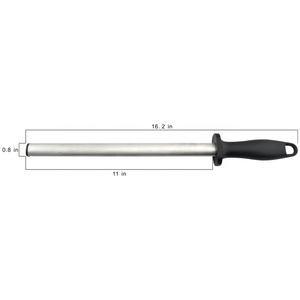
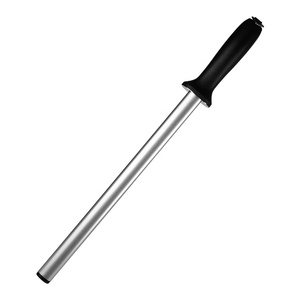
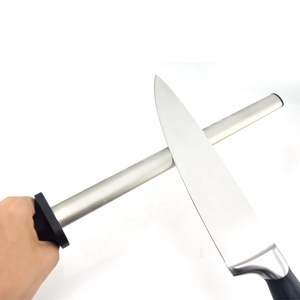
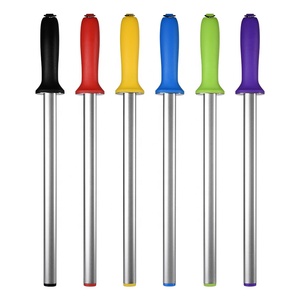





































To keep samurai knives in good condition, a samurai knife sharpener is used. There are several kinds of these sharpeners, each with its own features, pros, and cons.
Whetstone (Nagura):
A whetstone is a traditional samurai knife sharpener used to manually sharpen knives. It is made from natural or artificial stones and comes in different grits, ranging from coarse to fine. This allows users to adjust the sharpness of their blades according to how blunt they are. The whetstone is flat, so users can create an edge by rubbing the blade against it. It has been around for centuries and is still popular among people who value quality craftsmanship. Using a whetstone requires skill and care, as improper techniques can damage the knife or make it less effective.
Electric sharpener:
Electric knife sharpeners use motors to sharpen blades automatically. They have grinding wheels that rotate fast and can quickly restore the cutting edge of dull knives. These machines often come with sensors that detect how much pressure is being applied on the blade, thus preventing over-sharpening or damage to the knife. Electric sharpeners are convenient because they save time and effort compared to manual methods like whetstones. However, they may be too powerful for delicate knives, which require careful handling, so some users might find them unsuitable for certain applications.
Honing rod:
A honing rod, also known as a honing steel or butcher's steel, is a tool used to maintain and realign the edge of a knife blade. It is made from stainless steel, ceramic, or diamond-coated materials and has a long, thin, cylindrical shape with a handle at one end. When using it, the user strokes the knife along the length of the rod several times at an angle, which straightens up any microscopic bends or misalignments in the cutting edge caused by regular usage. This makes honing rods excellent for keeping knives sharp between sharpenings with whetstones or other methods since they do not remove much material from the blade. They are commonly used in households and professional kitchens to extend the life of kitchen knives and improve their performance.
Pull-through sharpener:
Pull-through sharpeners have two or more abrasive materials fixed on a frame. They are designed to be simple and easy to use. They can be made from stainless steel, ceramic, or other hard materials. These devices are compact and portable, which makes them great for people with limited storage space or those who want to take their sharpeners while traveling. However, some models may not be suitable for all types of knives. They might damage delicate blades due to their aggressive nature. They can also remove too much steel from the blade if not used correctly. Pull-through sharpeners are often used in homes and professional kitchens to quickly restore the edge of dull knives. They are popular among users who prefer convenience and speed over traditional methods like whetstones.
There are multiple designs of the samurai knife sharpener. Each one is unique and has specific advantages. They cater to various sharpening needs and preferences. From traditional to modern, these designs ensure that samurai knives can be kept in top condition for optimal performance.
Traditional whetstone
It is a flat stone made of natural material like sandstone. This design focuses on creating a sharp edge through friction between the blade and the stone. The whetstone is usually used with water as a lubricant. It has different grits for rough shaping and fine polishing. The traditional samurai sharpening method requires skill and practice to achieve the desired angle and pressure. It is about 15 to 20 degrees for knives. This design is simple but effective for creating a sharp edge that can cut with precision.
V-shape sharpener
This design consists of a V-shaped ceramic or diamond abrasive mounted between two parallel arms. The user pulls the knife through the V-shape opening to sharpen it. It is an excellent choice for people who do not know much about knife sharpening. It is easy to use and has a consistent angle. The V-shape angle is usually 15 to 20 degrees for a samurai knife. This design is compact and portable, making it suitable for use in small spaces like apartments.
Electric sharpener
As the name suggests, this design uses electricity to power the sharpening mechanism. The motor drives the abrasive wheels or belts to sharpen the knife. It is quick and convenient and has different sharpening stages and adjustable settings for different types of knives. It can be used for both blunt and sharp samurai knives. This design is automated and user-friendly, making it suitable for people who do not have much time or knowledge about manual knife sharpening.
Rod sharpener
This design consists of a long, thin rod made of ceramic, steel, or diamond. The user drags the knife along the rod to sharpen it. The rod is usually held vertically or at an angle. This design is good for realigning slightly misaligned blades. It is portable and easy to store. The rod can be used on both sides of the knife blade. It is a simple and effective way to maintain the edge of a samurai knife.
Pull-through sharpener
This sharpener consists of a pair of abrasive wheels or blades mounted on a base. The user pulls the knife through the gap between the wheels to sharpen it. This design is quick and easy to use. It has adjustable settings for different types of knives. The base can be made of plastic, metal, or wood, and some models may feature suction cups for stability during use. This design is suitable for people who do not have much time or knowledge about manual knife sharpening.
Different scenarios require different approaches to sharpening samurai knives.
In the kitchen
For culinary use, a samurai knife sharpener with a honing rod or whetstone is best. These tools can realign the knife's edge and refine its sharpness, which is all that is needed for the repeated cutting demands of cooking. The chef's knife may need to be honed daily and whetstoned weekly or monthly, depending on how often it is used.
In a woodworking shop
A woodworker's katana or tanto might experience more wear due to the hard materials they encounter. The woodworker may need to use a coarser grit whetstone to reshape the edge periodically and then switch to a finer grit for polishing. The samurai knife can also be enhanced using a carving blade or a knife fork.
In a martial arts dojo
When practicing kata (forms) or sparring with a partner, the dojo's katana may dull from striking and defensive techniques. To prepare for training sessions, the dojo's sensei (instructor) will have students use a nagura stone to polish the edge of their blades by sharpening the knife before each session. The students will also use a leather strop after every few cuts to realign the microscopic teeth along the blade's edge.
In a historical reenactment group
For accurate blade maintenance during demonstrations, the reenactors can use an oiled cloth to wipe down the blade after sharpening. The group can use a 1000/6000 grit whetstone to sharpen the blade and maintain the historical integrity of their knives.
What type of knives need sharpening?
When choosing a sharpener, consider what kind of knives users have. If users only have some samurai knives, a traditional whetstone may be best. But if users have many different knives, including kitchen ones, a multi-type sharpener will work better.
How often do users need to sharpen their knives?
For frequent users who need to sharpen their knives almost daily, choose a sharpener that works quickly, like an electric one. But for those who only sharpen occasionally, a manual option, like a whetstone, would be enough.
What materials are the blades made of?
High-quality samurai knives have blades made of hard steel or softer stainless steel. A traditional whetstone is gentle on the blade of a hard steel knife. But diamond or ceramic sharpeners work well for softer stainless steel blades.
Does it require portability?
If sharpeners need to be portable, choose a small manual one, like a folding whetstone or hand-crank sharpener. The electric models are bigger and need a power source, so they are not as portable.
What is the user skill level?
If users are experienced in knife care, a traditional whetstone lets them control the sharpening angle. Beginners may find it easier to use an electric sharpener that does not require as much knowledge.
What is the budget?
Manual sharpeners like whetstones cost less. But electric ones with more features will be pricier. Consider how much users can spend upfront and in the future for electricity to run it.
What features are important?
Look for features like multiple sharpening types, adjustable angles, and built-in honing to get the best value for money. These will help sharpen knives faster and more conveniently.
Q1: What is a Samurai knife sharpener?
A1: A samurai knife sharpener is a tool designed specifically to hone the edges of samurai knives.
Q2: How do users know which sharpener is suitable for their knives?
A2: When choosing a sharpener, users should consider factors such as the type of blade they have, the materials used to make its edge, and whether or not they want to maintain its sharpness.
Q3: What are the methods of sharpening in samurai tools?
A3: Samurai knife sharpeners use different techniques, including whetstones, ceramic rods, and electric machines.
Q4: Why is a whetstone popular in samurai sharpeners?
A4: The whetstone has been used for centuries as a traditional way to sharpen knives, making it popular.
Q5: What are the advantages of using a samurai knife sharpener?
A5: These tools offer precision, control, and the ability to maintain and create sharp edges on knives.